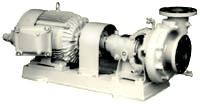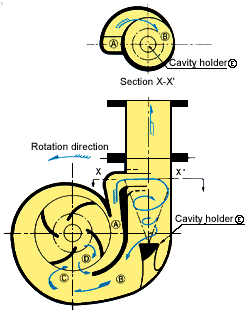| 
| Outstanding self-priming power |
| The internationally patented water-air separating mechanism reaches a maximum vacuum of 60-90kPa (6-9m water column) and displays outstanding self-priming power. |
| 
| No problem with suction of air during pumping |
| A large amount of incoming air can be separated and discharged during pumping. Even if pumping becomes subject to suction or mixture of air due to fluctuations of suction conditions, it continues pumping, constantly discharging air, and restores normal pumping operation as soon as suction conditions return to normal. Even continuous suction of air-containing water (i.e., gas-liquid two-phase pumping) is possible. |
| 
| Low NPSH |
| Even if cavitation develops due to fluctuations of suction conditions such as water level, temperature, or vacuum level on the suction side, this pump can still continue its pumping operation. Therefore, this pump does not require allowance for NPSH, and enables stable pumping operation even under fluctuating suction conditions. It naturally shows outstanding performance for extraction from sealed (vacuum) tanks. |
| 
| Simple structure without any inlet valve, No need for a foot valve |
| Due to its simple structure without any inlet check valve, it is robust and easy to maintain. Moreover, there is no need for installing a foot valve or an intermediate valve on the intake side under ordinary operating conditions.
Operation is also easy with no need for priming. |
| 
| Intake piping across embankments or long intake piping is possible |
| Because of superior intake power, intake pipes can be installed across embankments.
Intake piping with long piping is also possible. |
| 
| Outstanding pumping performance |
| This single-suction, single-stage centrifugal pump displays outstanding pumping performance in a wide range of specifications. |
| 
| Large selection of models, Large selection of materials |
| This self-priming pump has an incomparably wide variety of models available for easy selection. Further, a wide variety of materials are available, including FC, CAC, SCS and YOKOTA's corrosion and wear resistant special stainless steel casting (YST), to meet the needs of various kinds of liquid. |
| 
| Construction that can meet a wide range of specifications |
| Standard constructions include semi-open impellers for small pumps and closed impellers for medium and larger pumps. |
| The impeller has been improved to form ideal blades for high efficiency. |
| An oil bath lubrication system is adopted for bearings. |
| Maintenance is easy to perform because construction is simple and the number of parts in the water passage section is minimized. |
| 
| Stable quality |
| All special material products are manufactured internally in a continuous process to ensure stable quality. |








No comments:
Post a Comment